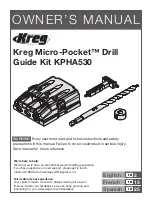
| English
12
2.650 rpm
E
5
The table below acts as a guide for selecting the
proper speed for various materials:
Drill
bit ø
Cast
iron
Steel
Iron
Alu
minium
Bronze
3
2.550
1.600 2.230
9.500
8.000
4
1.900
1.200 1.680
7.200
6.000
5
1.530
955
1.340
5.700
4.800
6
1.270
800
1.100
4.800
4.000
7
1.090
680
960
4100
3.400
8
960
600
840
3.600
3.000
9
850
530
740
3.200
2.650
10
765
480
670
2.860
2.400
11
700
435
610
2.600
2.170
12
640
400
560
2.400
2.000
13
590
370
515
2.200
1.840
14
545
340
480
2.000
1.700
16
480
300
420
1.800
1.500
18
425
265
370
1.600
1.300
20
380
240
335
1.400
1.200
22
350
220
305
1.300
1.100
25
305
190
270
1.150
950
NOTE:
The drill speeds specified above are merely sug
-
gested values.
4. Loosen the wing screws and push the right side
of the motor backwards to clamp the v-belt
again.
5. Tighten belt tension lock knob. Belt should
have approximately 13mm of play with thumb
pressure at mid-point of belt pulleys.
NOTE:
Safety switch: If you want to adjust speed you have
to open the pulley cover. The device switches off im
-
mediately to avoid the risk of injuries.
Removing the chuck:
Open jaws of chuck as wide as they go by turning
chuck sleeve anticlockwise (when viewed from
above). Carefully tap chuck with mallet in one
hand while holding chuck in other hand to prevent
dropping it when released from spindle nose.
Adjusting depth stop:
The depth stop enables the drilling of holes in the
work piece until a defined depth. You have two
options for that.
a. Drilling to a specific depth (Fig. 14):
1.
Mark the drilling depth (H) on one side of
the work piece.
2. Bring the drill bit down until the tip of
the mark.
3.
Hold the feed handle at this position.
4. Spin the lower nut (B2) down to contact
the depth stop (13) on the head.
5. Spin the upper nut (B1) down and tighten
against the lower nut.
6.
Τhe chuck and the drill bit are now going
to be stopped after traveling downward
the distance selected on the depth scale.
b. Depth scale method (Fig. 6):
NOTE:
For this method, with the spindle in its upper po
-
sition the tip of the drill bit must be just slightly
above the top of the work piece.
1. Lower the drill so far until the indicator (g)
points at the desired drilling depth of the
depth scale (e).
2.
Turn the lower nut (B1/2) downwards until
it reaches the lower stop (13).
3.
Lock the lower nut (B1/2) against the up
-
per nut.
4. The chuck and the drill bit will now be
stopped after traveling downward the dis
-
tance selected on the depth scale.
Positioning the work piece (Fig. 15):
As a general rule, use a machine vice or another
suitable clamping device to secure a work piece in
position. Never hold the work piece in place with
your hand. When drilling, the work piece should
be able to travel on the drill table for self-center
-
ing purposes. Ensure that the work piece cannot
rotate. This is best achieved by placing the work
piece /machine vice on a sturdy block.
NOTE:
Sheet metal parts must be clamped in to prevent
them from being torn up. Properly set the height
and angle of the drill table for each work piece.
There must be enough distance between the up
-
per edge of the work piece and the tip of the drill
bit.
NOTE:
Place a piece of backup material (e.g. wood) on the
table underneath the work piece. This will prevent
splitting or making a heavy burr on the underside
of the work pieces as the drill bit breaks through.
WARNING:
To keep the backup material from spinning out
of control it must contact the left side of the col
-
umn as illustrated. If the work piece or the backup
material is not long enough to reach the column,
clamp them to the table. Failure to do this could
result in personal injury.
NOTE
:
For small pieces that cannot be clamped to the
table, use a drill press vise (optional accessory).
The vice must be clamped or bolted to the table
to avoid injury from spinning or breakage.
Drilling a hole:
Make a dent in the work piece where you want the
hole, using a center punch or a sharp nail. Before
turning the switch on, bring the drill down to the
work piece lining it up with the hole location. Turn
the switch on and pull down on the feed handles
with just enough effort to allow the drill to cut.
Feeding slowly might cause the drill bit to burn.
Feeding quickly might stop the motor, cause the
belt or drill to slip, tear the work piece loose, or
DPB 13/5 PLUS
Summary of Contents for DPB 13/5 PLUS
Page 4: ...4 L I b 3 12 h 3 L I B1 B2 13 b 3 12 h 3 C D E F G B1 2 5 H 10 12 8 11 13 9 DPB 13 5 PLUS...
Page 27: ...27 www ffgroup tools com f f f f f f DPB 13 5 PLUS...
Page 28: ...28 1 5 mm f f f f DPB 13 5 PLUS...
Page 32: ...32 14 1 H 2 3 4 B2 13 5 B1 6 6 1 g e 2 B1 2 13 3 B1 2 4 DPB 13 5 PLUS...
Page 33: ...33 www ffgroup tools com 1 2 3 4 5 1 2 3 DPB 13 5 PLUS...
Page 54: ...54 DPB 13 5 PLUS...













































